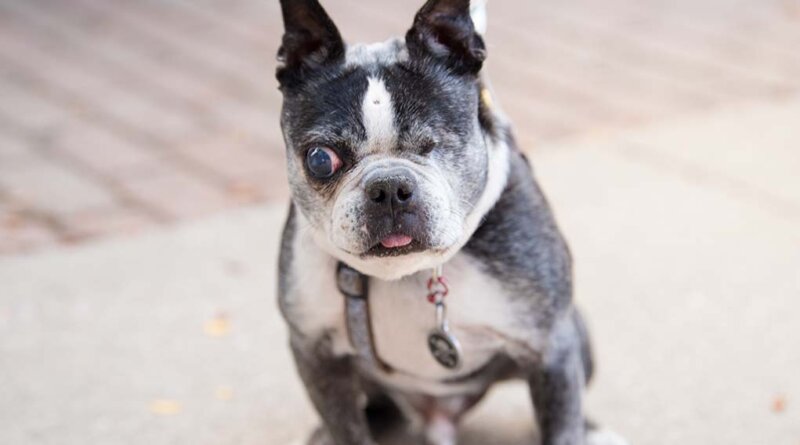Causes, Signs, Treatment and Prevention
Glaucoma in dogs is an eye disease characterized by damage to the optic nerve and peripheral vision loss which is caused by the increased pressure (intraocular pressure or IOP) within the animal’s eye. The cause is usually inadequate drainage of aqueous fluid in the eye and not overproduction of it.
There are two types and two classes of most common types of canine glaucoma: two primary and two secondary, and open and closed angle glaucomas. Either condition class can also have the type of either chronic or acute glaucoma, which depends on how fast the condition progresses and is treated, and how salvageable the dog’s eye will be.
Types of Glaucoma in Dogs
Primary Open Angle Glaucoma (POAG)
Primary open angle glaucoma in dogs is a rare type of glaucoma that is related to a mutation in the ADAMTS10 gene. This mutation and consequent POAG is seen most often in Beagles.
POAG in dogs is similar to the type of glaucoma found in humans and it progresses over time. Clinical signs of POAG in dogs include progressive narrowing of the iridocorneal angle (the angle created by the cornea and iris that lets the clear fluid between the lens and cornea drain from the eye).
The narrowing is caused by the accumulation of debris, decrease in pore size, and changes to the structure of the “drainage system” within the dog’s eye. As it gets harder for fluid to drain from the eye, pressure will build up and damage the structure of the eye itself.
Symptoms
Symptoms of primary open angle glaucoma in dogs include:
- Luxation (dislocation) of the eye lens
- Pupil dilation
- Atrophy of the optic nerve
- Eye discomfort
- Increased intraocular pressure
- Peripheral vision loss
- Complete loss of vision
Dogs are generally not diagnosed with primary open angle glaucoma until they reach middle-age, which is when the progression of POAG usually begins to be more noticeable. However, POAG can be detected as early as 8 months old in puppies. At this time, a veterinary ophthalmologist should look at your dog’s eyes
The only way to diagnose primary open angle glaucoma in dogs is to run DNA testing to verify the presence of the affected gene type. Once the eye is damaged from POAG and the retinal ganglia cells of the eye die, that damage is permanent.
Treatment
Treating this type of dog glaucoma is costly and difficult. Most often, the treatment is focused on using medications to limit the dog’s eye’s fluid production rather than draining fluid from the eye because this is a difficult process in animals.
There is no cure for genetic glaucoma, but management can help to delay serious damage to the eye and offer some symptom relief for your pet.
Common dog treatments for primary open angle glaucoma include medication, alternative medicine, and surgery to relieve pressure within the eye or to attempt to improve drainage.
In some cases, a shunt or drainage tube may be surgically implanted to promote better drainage of fluid from the eye. This type of surgery can be troublesome because scar tissue can impede the function of the tube or shunt, and tubes may need to be ligated post-surgery to cause fibrosis.
Lifetime treatment of POAG does have a high failure rate, and your dog will most likely wind up with some degree of vision loss if that happens.
Primary Closed Angle Glaucoma (PCAG)
Primary closed-angle glaucoma in dogs is the most common type of primary canine glaucoma. With this glaucoma type, the angle created by the iris and the cornea within the eye is severely restricted most often due to structural abnormality rather than an eventual buildup of debris.
This type of abnormality can be present in the puppy at birth or it can also develop with age as the iridocorneal angle narrows and ligaments within the dog’s eye that may already be dysplastic might become more dysplastic with age.
Dog breeds that are most prone to developing PCAG include the Chow Chow, Bassett Hound, Siberian Husky English Cocker Spaniel, and American Cocker Spaniel. Female dogs are also more likely to develop PCAG than males.
Symptoms
Symptoms associated with primary closed angle glaucoma in dogs include:
- Multiple attacks of congestion within the eye
- Swelling of the cornea
- Atrophy of the optic nerve
- Eye discomfort
- Increased intraocular pressure
- Complete loss of vision
PCAG can be characterized by numerous attacks of congestion or one long, ongoing attack. These attacks are regularly caused by dim light exposure or any situation that triggers a stress reaction (stress causes a “midrange pupil” size and this increases the severity of blockage of the eye’s already compromised drainage system).
PCAG almost always results in the complete loss of vision in dogs because of how quickly it progresses in comparison to primary open-angle glaucoma.
Treatment
Treatment for primary closed-angle glaucoma is similar to the above mentioned POAG.
Surgery for PCAG may be used to open drainage within the eye if the iris and cornea are adhered, but if the lens covers the majority of the cornea, this surgery cannot be performed successfully.
PCAG is most often diagnosed in dogs at around age 5 due to the ability of the eye to compensate in the younger dog. As ocular components grow, the eye is less capable of compensating for limited fluid drainage and symptoms appear quickly.
Once symptoms are noticed in PCAG, it’s crucial to seek out a veterinary ophthalmologist immediately to manage symptoms and avoid retinal damage of your dog’s eyes.
Secondary Glaucoma in Dogs
The above mentioned primary open angle glaucoma and primary closed angle glaucoma in dogs are the result of natural defects within the eye or defects that develop as your pet gets older. These types of dog glaucoma are not the result of another illness or event.
In the case of secondary glaucoma, however, the development of glaucoma symptoms (which are similar to the above signs) is the result of something else happening.
Most often, secondary glaucoma in dogs results from trauma, injury, or cataracts in the eye. As the dog’s eye is damaged or injured, the fluid drainage system within the eye is slowed or completely blocked.
Treatment
Depending on the specific cause, treatments vary but they should always be administered as soon as possible. If an injury contributing to glaucoma is not treated immediately and pressure within the eye is allowed to build up, the optical nerve can become permanently damaged and result in your dog’s blindness.
Secondary glaucoma may be classified as open or closed angle glaucoma depending on the ability of the dog’s eye to drain and the eye structure post-injury.
Treatment for secondary glaucoma in dogs requires treating the underlying condition that prompted the development of glaucoma. For example, in dogs with cataracts that can be removed surgically, it may be effective to put a halt to any progression of glaucoma symptoms and pressure within the eye can be relieved with medication or laser treatment.
In other instances, such as after an accident that causes significant damage to the dog eye structure, the best solution may simply be to remove the eye to reduce pain and stop glaucoma from becoming an ongoing problem.
What to Do When Your Dog Has Glaucoma
Note the Diagnosis and Your Vet’s Recommendations
Much like a diagnosis of cancer, the mention of the word “glaucoma” can send your brain reeling and prevent you from hearing anything else that your vet has to tell you, but you need to keep track of the diagnosis and for vet’s recommendations on dealing with dog glaucoma and what your next steps are.
To avoid missing out on important information about your pet’s glaucoma condition, there are a few things that you can do:
- If your dog is going to the vet for testing, take a trusted family member or friend with you who can listen when your brain shuts off.
- Take a pen and paper and make notes to remind yourself of what your vet told you so even if you’re not listening, you can look back at your notes.
- Ask your vet if they would mind you tape recording or videotaping your conversation so that you can look back on it when you are feeling more clearheaded.
- Ask your vet to write down important notes or key points for you ahead of time or ask if they can have a vet tech do it instead. This will give your vet time to get notes made before you show up to pick up your pup if you left them for testing or have been waiting for test results.
Seek Out a Second Opinion
Whether you don’t trust the veterinarian that you saw because they weren’t your regular vet or you have a gut feeling that something else is going on, it’s okay to seek out a second opinion from another vet. It’s always better to put your mind at ease before starting your dog on a glaucoma treatment plan even if it costs you an additional vet visit.
Consult a Specialist
Depending on your dog’s glaucoma type and cause, your vet may recommend consulting a veterinary ophthalmologist. Just like human ophthalmologists, canine ophthalmologists specialize in the eye are will be able to give you a much more detailed account of what is going on with your dog’s eyes. They may also be familiar with newer developments in dog glaucoma treatment that your regular veterinarian is not aware of.
When you consult the specialist, ask any questions that you may have and be sure that you fully understand what they are telling you. If they use a term that you don’t understand, ask them to explain what it means.
If they suggest a specific treatment, have them explain what that treatment means, what it does, how it’s performed, and what the desired result is. The more you know the less anxious you will be when it comes time to pursue treatment of glaucoma in dogs.
How to Afford Glaucoma Treatment
Although your dog’s glaucoma may well result in a complete loss of their vision, it’s important for you to realize that symptoms of glaucoma in dogs can be treated, so you should remain hopeful for both your and your dog’s sake.
Yes, you and your pup will both need to adjust. Yes, your dog will have some bumps along the way. And yes, managing glaucoma can be expensive, but where there’s a will there’s a way, and the following options can make the expense of dog glaucoma treatment for your pooch more affordable:
- Look into financing or payment plans offered by your vet.
- Consider using a credit card that offers cash back rewards when making any payments on veterinary bills.
- Look into veterinary financing options like Care Credit (although it’s best to use your own credit card options first because they tend to be more affordable and sometimes offer rewards.)
- Call around to get price comparisons from other vets in your area. You can even consider pursuing treatment in a neighboring state if the cost varies considerably (and it usually does!)
- Contact a local rescue and ask if they have any recommendations that can offer you a discount on your dog’s care based on financial hardship.
- Contact the local shelter and ask for their veterinary recommendations too.
- Look into veterinary insurance to see if your existing plan covers the cost of treatment or if a new plan would cover your dog’s condition after a grace period.
- Look into starting a crowdfunding campaign to raise money for your dog’s treatment.
- Contact one of the following pet care financial assistance charities to see if you qualify for financial aid:
You can also find a more comprehensive collection of financial assistance programs for specific dog breeds and specific states listed on the BestFriends.Org website and remember to check these tips on how to save money on vet bills and dog health costs.
READ NEXT: Dog Won’t Open His Eyes? Here’s What It Means (and what to do)










earch our drug database. Medicament prescribing information.
https://viagrapillsild.com/
Read information now. Actual trends of drug.
dark web drug marketplace darknet market list darknet drug links